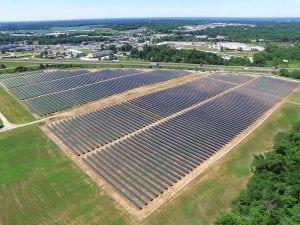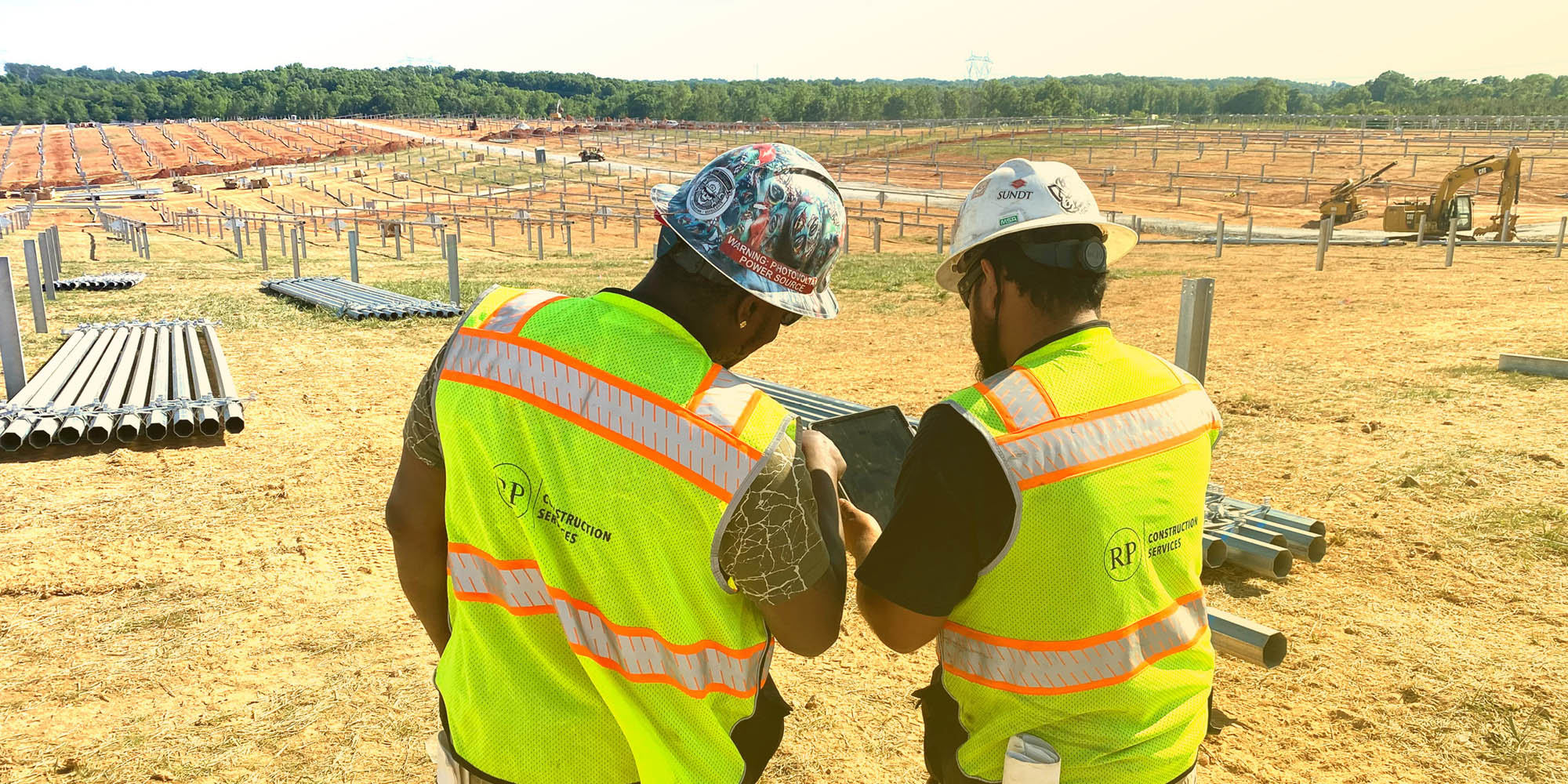In this interview, RPCS founder and president Eb Russell explores the factors behind how solar trackers are taking over the utility-scale market, as well as giving insights on the solar contracting business in the wake of the Section 201 tariffs.
 pv magazine: Can you give our readers a brief background on the history of RP Construction Services, and your relationship with Array Technologies?
pv magazine: Can you give our readers a brief background on the history of RP Construction Services, and your relationship with Array Technologies?
EB RUSSELL: Our relationship with Array Technologies really initiated back in 2007. I was in a business development role with Suntech, and it was M&A activity that Suntech wanted to pursue.
Array was a very small company at that time, mainly known for their dual-axis solar trackers, and the utility-scale solar market really had not begun. The first couple of projects were the Nellis Air Force Base, which was an MMA Renewable Ventures and SunPower project, and then Alamosa, which was a SunEdison project. SunEdison was one of my Suntech customers, and they were also using this new, horizontal single tracker from Array. It was Array’s first product in that marketplace.
Dr. Shi, the founder and CEO of Suntech, agreed in my assessment of Array, so he and I visited Albuquerque to meet with Ron Corio, the CEO and founder of Array. Suntech was moving forward with an acquisition of Array Technologies. And if it were not for the collapse of the worldwide markets at the end of 2008, that would have happened.
I decided to leave Suntech and set up Russell Pacific, LLC, as a manufacturer’s rep firm, and using some of my contacts in the industry, Ron allowed me to be his sales force. He really had no sales force. He had a few engineers, but no actual sales team.
From 2009 through 2014, Russell Pacific did sales for Array Technologies. Most of the industry thought that I was direct with Array. I carried the title of VP of sales at Array Technologies, had an Array email address, handed out cards, everything else. But from a business standpoint, it made more sense for Array to pay Russell Pacific via a rep agreement.
In mid-2014, in talking to Ron about future growth, we looked at two big areas of growth: international growth in the utility market, and then taking care of that sub-10 MW market in the United States.
From 2009 to 2014, we had tremendous success. We sold 3,000 MW, 250 projects. We really had no time to address projects less than 20 MW. We had success in all the largest projects in the United States. To name a few, the Mount Signal project was 268 MW, Centinela was 250, Arlington Valley was 175—those kinds of projects.
So in 2014, Ron discussed what the domestic market would need, in that smaller project arena. I was very adamant that you had to offer the project in a DirecTV kind of approach: fully installed, designed. Solar contractors selling ground-mount systems, they don’t want to have to deal with the ground-mount solar tracker installation complexity.
He did not want to add construction to an arm of Array Technologies. He thought that would be dilutive to his valuation. And I can’t disagree with him. So I sought to help hire my replacements, and to help build a U.S.-based team, and Ron knew he was going to start to build an international team. In 2014, I partnered with a long-time friend in the solar industry, Adam Larner. He had all the contracting licenses, and we started RP Construction Services, Inc., the contracting arm of Russell Pacific.
It is a separate entity, and that business focuses only on designing, laying out, and typically installing the Array Technologies solar tracker. Occasionally customers will have their own installation team that they would like to use. In 2018, about 90% of the product we design and sell, we also install. There is about 10% that others would like to install.
pv magazine: Since you are so deep in the tracker industry, can you qualify the importance of the choice of tracker for utility-scale solar projects? What makes this such a critical consideration?
RUSSELL: The horizontal single-axis solar tracker, the north-to-south row, tracking east-to-west, capturing the big move that the sun makes every day and not worrying about the angle of the sun in the southern sky…. the closer to the equator you are, the better it works.
It works significantly well to about the Canadian border. However, you do still see horizontal single-axis tracking even into Canada.
Early on, the returns on solar were very very good. The PPA rates at the utility level were very high, and investors could make their target rate of return with fixed-tilt. They knew they could make a higher rate of return with trackers, but they didn’t have to, and they decided not to take the technology risk.
We had 90% market share during that time. Array Technologies in a sense created the tracker market. The reliability of the Array product allowed more and more folks to understand that the tracker does not add a lot of technology complications or product reliability risk.
Economics for solar have come further and further down, PPA rates are lower and lower, costs are lower. Now tracking has almost become a requirement, especially at the utility level. Looking at the different data sources, about 95% of the larger utility-scale market in the United States is now going with horizontal single-axis solar trackers.
You pay, on average, 6 to 7% more at the project level, and you are gaining anything from 10 to 25% more, depending on your geography. There’s a very clear economic benefit.
Solar trackers also correlate very well to the time of use. So typically the highest demand on public utility power companies is between 11 AM to 7 PM on May 1 to September 30, and the horizontal single tracker outperforms fixed-tilt the most in the summer months, when the sun is making that high arc over the array. The economic gain can be even more significant than your total kilowatt-hour harvest gain. The economic gain, because of TOU rates and generating power late into the evening in the summer, you are still harvesting energy, and a fixed-tilt system has peaked out about noon. That’s where trackers are really making significant gains in states like California.
Several states are now adopting time-of-use rates at the utility level. It has become a necessity, in what we call distributed utility, it is really behind the meter distributed generation sites, because they project site looks more like a micro-utility site. Their solar trackers in 2017 represented around 50% of the market, with fixed-tilt representing about 50%. Our belief is that this will increase to 100% tracker by 2022.
It’s a lot bigger market to penetrate, a lot more companies that you have to convince, a lot more minds to change, but that market is moving towards tracker. It really doesn’t make a lot of sense not to track, in almost any location.

pv magazine: So when you say that you think the whole market is going to go over to solar trackers by 2022, is that the entire utility-scale sector, or just the distributed utility-scale sector?
RUSSELL: I believe that the entire ground-mount solar market—utility and distributed utility—will move toward solar trackers, and that fixed-tilt will become almost negligible in its market share. I think it is evident in almost all companies that were competing in that fixed-tilt space. Almost everyone has brought a tracker to market, and is putting almost all their market development and focus on the tracker.
The market is driving this. It doesn’t take that much more, incrementally, to install a tracker than it does to install a fixed-tilt. In fact, some of the tracker products go in so fast that they have installation rates that are less than the fixed-tilt products. So the cost differential to now track is very small. The tracker market in general has offered a very reliable product from all manufacturers, not just Array Technologies, and so why not?
Why would you not track if you can increase your energy harvest, and you can increase your return on investment?
pv magazine: What about sites in the Northeast? Do you expect some sort of geographical limits to the penetrations of solar trackers, given the natural conditions of the sunlight?
RUSSELL: That is where some fixed-tilt will still survive. You are more challenged, for sure, the further north you go. Because they track, and most track somewhere between 45 degrees and 60 degrees, maximum. But they are sweeping in a fairly large angle, from 90 degrees to 120 degrees, depending on the brand.
Because of that the system has to go up higher, and rows cannot be interconnected with other rows.
Why is that important? In fixed-track systems you can create a resistance to uplift by interconnecting rows, so that the whole array is resisting the uplift force, versus a single row having to deal with all the force within that row.
Fixed-tilt mounting might be ideal for snow load and wind. A 25-degree tilt is that perfect spot where wind doesn’t get a good chance to have uplift, and it also doesn’t hold snow.
By contrast, solar trackers have to deal with the completely dynamic sweep of the tracker, which means greater loads.
So a lot of what drives that decision: the economic returns are already a little less, the further north you go, but then if you have site-specific constraints, say if for instance the site is a brownfield and you can’t penetrate the earth, that is where fixed-tilt will still make more sense, because it is feasible to do a ballasted or minimal penetration fixed-tilt, where a tracker system is going to need more of a foundation. The ballasted system would become too large, and the cost-benefit would become unaligned.
The same is true if you have really challenging rock or other kinds of foundation work. And perhaps if you have very narrow sites—north-to-south—or long—east-to-west—all trackers are going to have a certain kind of equipment and hardware on each row, related to the tracking. And if you can’t put many modules in that north-to-south direction, you still have to have all that same hardware, electronics, and equipment to make it track, then a fixed-tilt system might be more cost-effective.
If you have a more open space, and you don’t have extreme subsurface conditions, I think trackers will prevail.
pv magazine: So to move over, can you talk about the general condition of the solar EPC business in the United States these days? Has the market recovered from the initial shock of the Section 201 tariffs?
RUSSELL: We are involved with a lot of the large EPCs, and we are doing a lot of their distributed projects. Our perception is that everyone has been experiencing a very large, what we call “air pocket,” as a result of the tariff. You had indicated in one question what is more damaging—the uncertainty around the tariffs, or the tariffs themselves.
I think the uncertainty has been more damaging. That long period of time between last June and the end of this January. None of the tax equity money coming into solar could actually close on a return to be able to come to a full understanding of what the numbers are and be able to close.
It created a real air pocket. And solar can’t turn on a dime. There are a number of development milestones: PPAs, permits, land rights, land-use acceptance, that developers will not spend on until they have financial commitment from their investor partners.
What we’ve seen in 2018, January first to date, we’ve seen a 4x increase in proposals, in both the quantity of proposals and the number of megawatts related to the proposals, than we saw in the comparative quarter or timeframe in 2017. But hardly any projects have been started.
They all look to be back-ended into the back half of this year. This backend of 2018 looks to be insane. We are picking this up from almost all the EPC businesses we are speaking with. We are usually one of their sub providers. All of their projects are pushed out a little bit. Most of their projects are real, they are moving further along, but the uncertainty of this tariff created this air pocket, and now we are seeing it finally turn. A number of projects are starting up here in May, more start in June and July, and we could finish the year with one of the best years in solar, but it is all going to be in the back half of the year.
pv magazine: Can you comment on any impact that you are seeing from the pending steel and aluminum tariffs so far?
RUSSELL: In that, too, again, it creates uncertainty. The tracker manufacturers, the steel I-beam providers. . . . Fortunately, in utility-scale solar pricing, the modules represent probably more than 40% of the cost of these projects. So tariffs looming on modules really made it hard for the tax equity to put a stake in any of these projects and commit financially.
On the mounting system, whether it is tracker or fixed-tilt, yes, those steel and aluminum tariffs are going to have an effect.
Whether it is tracker or racking, that product is probably more like 10 to 15% of the project. So the risk of a looming tariff can be absorbed. A project can move forward, knowing that there will be some effect on their return on investment by the time it is done. It’s not restricting as much, although for very large projects, the 100 MW+ projects, for sure those little bits of tariffs are meaningful. Those projects are so razor-thin on return, so the make-it or break-it point is more narrow. There is probably a bigger effect on the large utility projects than there is on our world, which is the 20 MW and under market.
pv magazine: Interesting. So anything we haven’t talked about that you think our readers need to know?
RUSSELL: You asked about the general condition of the EPC business. One trend that we are seeing right now is to avoid the margin stack. We are seeing that developers who would traditionally go to an EPC to avoid all the risk, are now turning to various trades—mechanical, civil and electrical—to provide those independent contracting services. We’re seeing developers, at least in our market, are starting to become interested in direct relationships with folks like ourselves.
They will become an EPCM, where they can get comfortable around the engineering and the procurement and direct hire us, for our tracker layout supply and installation. They will direct hire an electrician, and they will direct hire civil.
We are seeing, at least in the 20 MW and under segment, the avoidance of a market stack, and maybe a shift away from traditional EPC business towards a developer directly contracting with the individual trades.
Interview conducted for pv magazine USA by Christian Roselund
View the original article here.


 pv magazine: Can you give our readers a brief background on the history of RP Construction Services, and your relationship with Array Technologies?
pv magazine: Can you give our readers a brief background on the history of RP Construction Services, and your relationship with Array Technologies?

